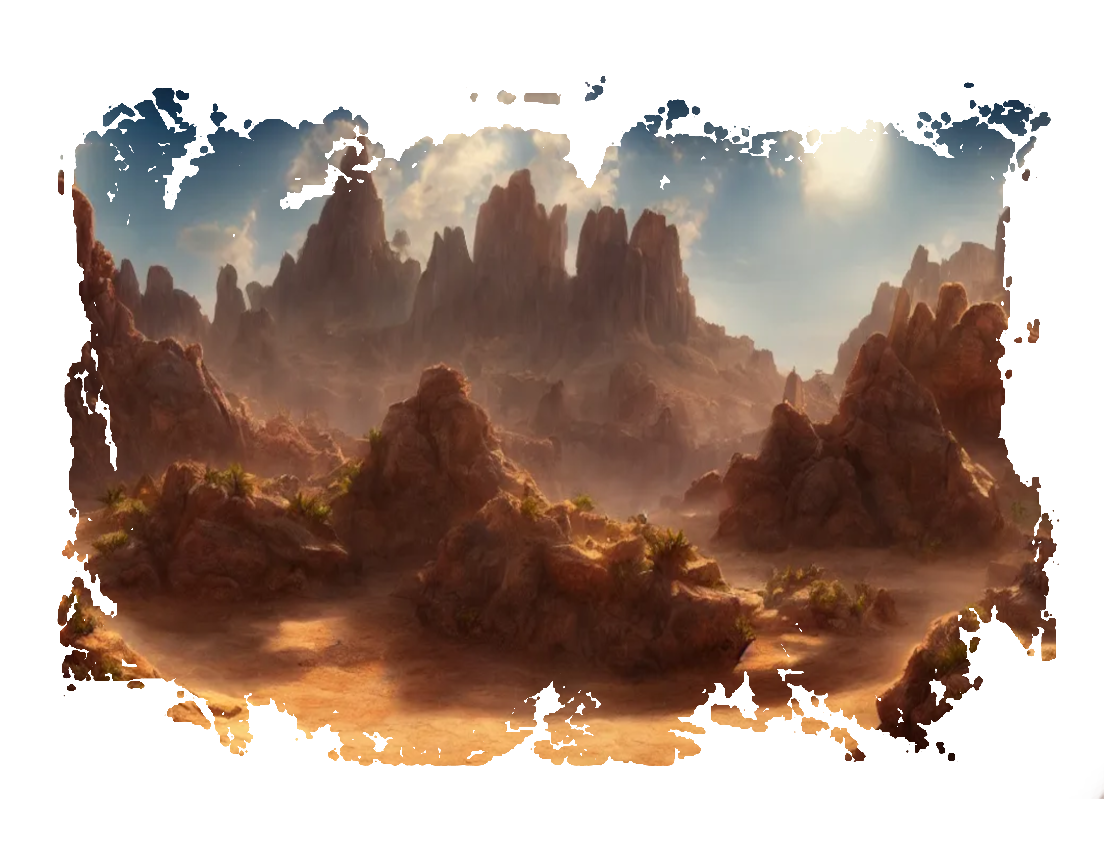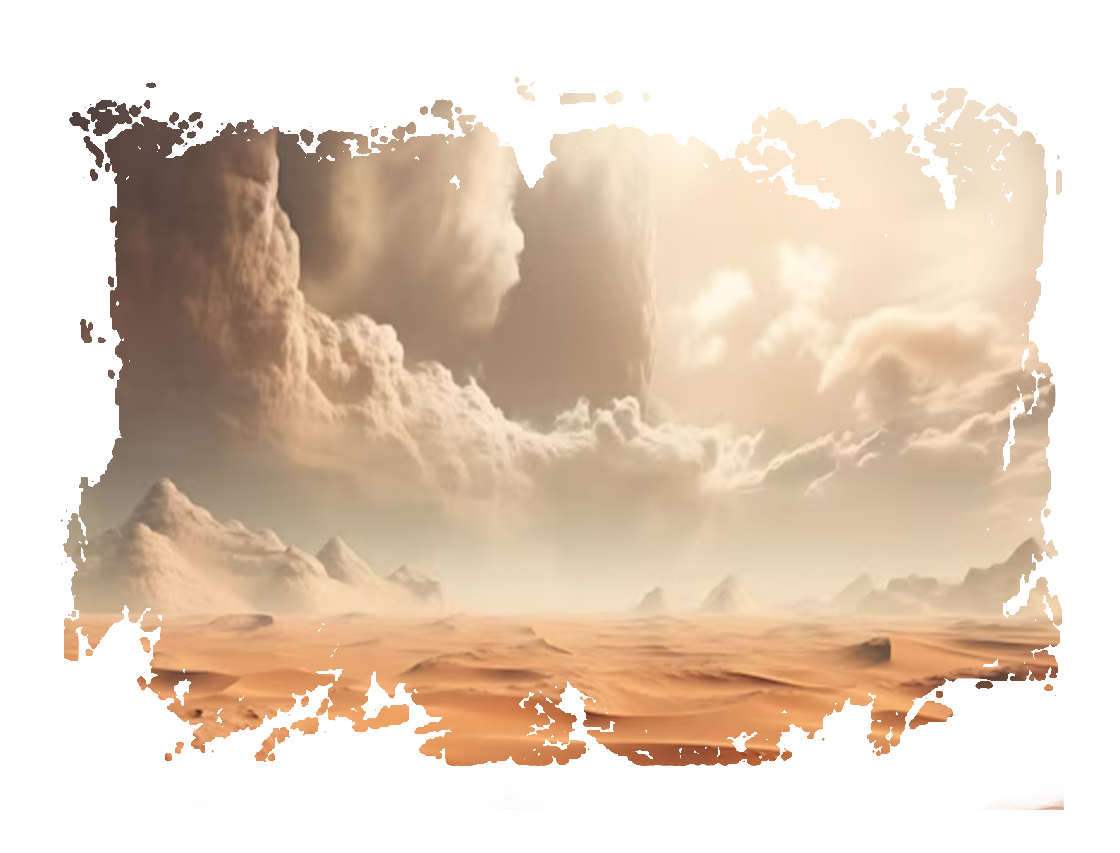
The Fire Region - Azmith
in Yunan's World AtlasSavage Sands
"Amidst the relentless expanse of the scorching desert, Emily found herself stranded. The sun beat down upon the arid landscape with an intensity that seemed to sear through her very being. Each breath she took felt like swallowing fire, the parched air leaving her throat raw and her lips cracked. With each passing moment, the shimmering heat waves blurred the horizon, disorienting her senses and amplifying her desperation. The shifting sands beneath her feet offered no solace, only sinking deeper into the unforgiving terrain with every step. As the hours stretched into an agonizing eternity, Emily's resolve began to wane, it felt as if the land itself wished to see her end. It felt as if it hated her." - Excerpt from Yunan's Guide to the RealmRegion Info
Alternative NamesThe Fire Region, Azmith, The Rogue Sands, The Tyrant
Ruling Kingdom
The Golden City
Major Languages
Common
Prominent Demographics
Humans, Sun Elves, Beastkin
Overview
Azmith occupies the entire northern half of the continent it shares with Zul. While the whole landmass is shaped by frequent volcanic eruptions and seismic activity, Azmith stands out as the flatter, lower-altitude region. These geographical traits also mark the boundary between Zul and Azmith, both physically and politically.Azmith is known for its vast, unrelenting landscape of dusty orange drylands and endless, ocean-like dunes of fine sand. Only a few scattered settlements exist, all controlled by the powerful city-state of the Golden City. The harsh climate and hostile wildlife make it nearly impossible to live comfortably without significant resources. Surviving off the land is fraught with danger and often requires either great wealth or substantial effort.
Climate
Azmith is known for its extreme desert climate, with scorching daytime temperatures and minimal rainfall. It's no surprise that it holds the record for the highest surface temperatures in the realm. This intense heat and lack of rain have transformed most of Azmith into an arid, sandy desert, which transitions into dusty cliffs and hills near the center of the continent and the northern Zul border.However, the challenges don’t end when the sun sets. As "winter" approaches, daytime temperatures slightly ease, but nights can become dangerously cold. Unprepared travelers risk hypothermia, as temperatures can drop well below freezing. This happens because the desert sand reflects sunlight rather than absorbing it. While this contributes to the blistering heat during the day, it also means the sand doesn’t retain heat to warm the air at night, leaving the nights harsh and frigid.
Natural Resources
Azmith, often called "The Desert Gem," earns its nickname from its abundant mineral and gemstone resources. The region's economy relies heavily on large-scale mining operations, which produce iron, copper, gypsum, and a significant portion of the world's gold ore. Its mines are also rich in gemstones, ranging from quartz and amethyst to ruby, agate, and many other varieties, making Azmith the leading producer of precious stones and rare minerals globally.Beyond mining, Azmith is a hub for exotic goods, offering products such as animal-based items, magical substances, spices, and cosmetics. However, the region is also known for its controversial slave market, which remains a deeply ingrained part of its culture despite being outlawed in many other places and seeing declining demand. This institution reflects Azmith's historical evolution from a barren desert into a thriving yet complex economic center.
Society
Life in Azmith demands either wealth and social finesse or, lacking that, resilience and grit. Most inhabitants of the sands lack privilege and must endure harsh conditions, lest the environment or their peers overwhelm them. Society is starkly divided between those with power and those without.The Golden City, home to Azmith’s elite, dazzles with seemingly endless resources and luxuries. However, its splendor rests on a foundation of exploitation. Slave labor, integral to Azmith’s culture, built the city and sustains its opulence. Aristocrats and merchants rely on slaves for daily tasks, and skilled slaves may rise to positions akin to knights, serving as bodyguards.
Beyond the aristocracy, nomadic herders circle the coastal villages, while bustling port towns thrive on fishing and trade. These ports, with their depots and bazaars, attract foreign visitors and employ mercenaries to guard goods transported inland to the Golden City—a profitable and sought-after trade.
Most of the population in the Shackle and the Cage, two of the settlements not in the middle dunes, are soldiers and their families, trained people of war who act as the standing army for the Golden City, though some take their training to other towns or even dedicate their lives to guarding caravans as there is never a lack of people looking to make it through the sand.
World Codex
Story & Moderation Team: ames, capolock, foxhound99, skarra365, 1800HOTBEEF, Nekobot
Community Manager: staratly
Website Manager: foxhound99, skarra365
Community Manager: staratly
Website Manager: foxhound99, skarra365




